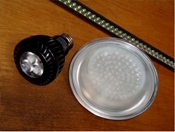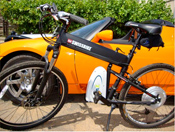
We are solar poweredWe welcome your thoughts & suggestions: notably it was your requests over many years regarding our energy and investing ideas that helped us to conceive the WilderHill Clean Energy Index® (ECO), the first Index on Wall Street for renewable energy solutions - now successfully run by WilderShares, LLC. Starting from a modest showcase of energy solutions and the first Clean Energy Index�, we're now working towards a broad and applied demonstration of renewable power in both buildings and transportation.Many of the energy options in WilderHill Indexes are technologies that we not only address in a technical sense but also utilize everyday. We believe practical knowledge-gained can assist in discussing clean energy ahead. For example we are intimately familiar with how solar power, electric cars, and efficiency can be sensible today. This is more than theoretical; at our 1-acre San Diego site we utilize several different systems to:
Completed in 2009, this SolarSense system makes great sense. Arguably solar-cars - with 100% renewable green transport is a compelling idea that ought to be scaled up rapidly. Not only because of climate change, sea-level rise and ocean acidification that�s underway, not only because it�s both smarter and cheaper than reliance on fossil fuels, consider this is now a solution that makes sense in its right. One way to do so soon will be with small, lightweight and most importantly very inexpensive EVs - including radically innovative simple 2-wheel, 3-wheel, and 4-wheel designs given that upfront costs of solar have been falling dramatically. To visualize combining solar panels with electric cars, arguably a better solution for powering both transport and buildings, start with the solar. For generating our power we are harvesting considerable electricity from the sun using PV (PhotoVoltaic = electricity generating) panels. Totaling 6.65 kilowatts (kW) these are 'grid-tied' meaning this building is connected to the grid; during daylight we generally make much more power than we consume automatically 'selling' power to the grid. At night it�s reversed; we �buy� power from the grid � our meter runs the opposite way. Grid-interconnection simply means we're able to avoid cost of batteries while it allows for rebates from the State of California. Also using the grid leverages and increases value of PV. Overall in terms of costs, solar PV has performed well in cost/benefits, its return on investment, and in actual practice. First phase was 3.85 kW of PV calculated to achieve payback in approximately 10 years and was installed in 2003 (solar PV system costs). A quick payback was mainly due to *California State solar subsidies, and *Time of Use (TOU) metering by our utility. Certainly upfront costs for the system were significant. However we estimate after generating solar power for 10 years, we've recouped full return on investment. Thereafter most electricity here including 'fuel' for our electric vehicles (EVs) is at no charge. That stability contrasts well with highly dynamic utility rates that usually go up over time; instead this smartly will go on making power for years to come. Solar panels are the main cost and carry a manufacturer's Limited Warranty of 25 years � notably a longer panel life is expected, given the performance of old panels in service for decades. (The two Inverters carry a shorter life and will need to be replaced). We expect to see years of profitable PV operation and feel without any undue sentiment, that this can be a sensible return on investment.
We first installed 21 new 185-watt PV panels (see spec sheet) with then high 14.2% module efficiency to get most use of flat rooftop space. Those panels made in the USA were at that time among the most efficient consumer PV, with a power dense monocrystalline design. Monocrystalline panels were matched in 3 strings to a 3,500 watt inverter (along with two web-based real-time monitoring systems) in one of the first such applications then in California. We later added 24 surplus multi-crystalline PV panels built in 1999 rated at 120 watts each, choosing a passive inverter design. Latter panels + that 2nd inverter were rated 2.8 kW; total production for both Phase 1 & Phase 2 systems delivering 6.65 kW overall. As illustrated by monitoring data in detailed graphs, we readily obtained module efficiencies ~5% to 10% over manufacturer rating. Importantly since 2003 inception of this solar PV, it has provided us about 24 kWh (kilowatt/hours) per day of electricity. This 24 kWh per day is an amount we think of as "One Sun" and is relevant with addition of our electric cars below. It�s also an average. We will see for instance more on longer, typically sunny, non-foggy days of late Summers & Fall. Conversely on shorter Winter days, or on any cloudy or foggy days, solar production will be very substantially less.
Similarly fuel costs actually go down towards zero over time when combining PV with virtual 'solar-powered' electric cars in transport, contrasting highly favorably with gasoline. Moreover this 'solar EV' needn't be slow like a gasoline-car (a "gasser"); not only does the EV avoid all oil changes and maintenance of a gasser, it can be considerably better and more fun to drive as well. As noted we make about 24 kWh over an average day and call this 24 kWh/day, 1 Sun. Break that one Sun down over 24 hours, and roughly 1 kWh is being made each hour; we call that 1 kWh per hour one "sol". Two hours is thus 2 kWh, or 2 sol, etc. With a very fast electric vehicle (EV Phase 1) we get about 3 miles of range from each kWh of sun in our typical driving mix (we get 0.330 kWh/mile). Thus 1 sol = 3 miles range. Simply, 24 kWh/Day means we can drive this car roughly 72 Miles Per day from Sunlight alone. Thus it has a range of 72 Miles Per day of Sun. Translating how far you can go from off sun power alone, and seeing it�s 72 Miles Per Sun (MPS) or 3 miles per sol (3 m/sol), may feel more intuitive and simply more elegant than oily old MPG. Some days however it's very cloudy with peak-measured irradiance under 100 W/M2 or under 5 kWh all day. Solar making under 5 kWh on a cloudy, or Winter day means the MPS figures for our cars then go very low the other direction indeed. Also without any subsidies, it's clear that both costly solar PV, and EVs have in the past been uneconomic. But as they grow in use, improve in performance and real costs come down fast, their calculus changes dramatically.
Besides the solar PV that we use for electric power and transportation, avoiding much utility electricity and gasoline, we are using two different solar water heating systems. Both are thermal and rely on collecting and focusing the sun's warmth to heat water. First there's a small primary system that's completely passive. A larger secondary system uses an efficient multi-speed AC motor pumping motor (powered by PV arrays+inverters).
As important as is energy made by renewables, attention to demand is just as vital. Clever reduction in use delivers results from the very start; it�s here that inexpensive, effective and readily worthwhile steps can first be taken. We thus monitor our demand in real time � since it's as useful to reduce need in the first place � as it is to make all energy renewably. Solutions can be brilliantly simple. Passive building designs can for instance better heat and cool at very little cost. Or substituting in LEDs, in place of hot incandescent bulbs helps mitigate the need for cooling brought on by inefficient bulbs in a first place. One large lighting structure is rated by its manufacturer at 720 watts: by installing efficient bulbs we consume ~80% less power for similar light � and avoid unwanted heat. Demand-side reduction can take many paths: think of hybrid solar/electric bikes; a digital thermostat adjusting heating to precise time of day; retractable awnings letting sun in cool hours or shading when hot; energy efficient appliances; multi-speed pumps etc. Each is a small step, but together they can add up to a larger difference. For efficiencies yet farther afield, we seek smarter solutions in green waste & water-use. For instance we compost green waste, and have tasty vegetable gardens in an area once covered by water-thirsty, nonproductive lawn. Instead of just grass, there�s now abundance. Efficiency once started is rewarded, and often doesn't end at shores of energy alone. Even small efficiency steps may yield a big difference as gains snowball. You can easily even find yourself looking back & thinking, why didn�t we do that before?!
|
|||||||||||||||||||||










